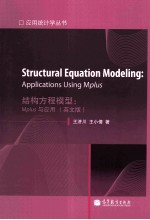

应用统计学丛书·结构方程模型 Mplus与应用 英文版PDF电子书下载
- 电子书积分:15 积分如何计算积分?
- 作 者:王济川,王小倩著
- 出 版 社:北京:高等教育出版社
- 出版年份:2012
- ISBN:9787040348286
- 页数:453 页
1 Introduction 1
1.1 Model formulation 2
1.1.1 Measurement model 4
1.1.2 Structural model 6
1.1.3 Model formulation in equations 7
1.2 Model identification 11
1.3 Model estimation 14
1.4 Model evaluation 17
1.5 Model modification 23
1.6 Computer programs for SEM 24
Appendix 1.A Expressing variances and covariances among observed variables as functions of model parameters 25
Appendix 1.B Maximum likelihood function for SEM 27
2 Confirmatory factor analysis 29
2.1 Basics of CFA model 30
2.2 CFA model with continuous indicators 42
2.3 CFA model with non-normal and censored continuous indicators 58
2.3.1 Testing non-normality 58
2.3.2 CFA model with non-normal indicators 59
2.3.3 CFA model with censored data 65
2.4 CFA model with categorical indicators 68
2.4.1 CFA model with binary indicators 69
2.4.2 CFA model with ordered categorical indicators 77
2.5 Higher order CFA model 78
Appendix 2.A BSI-18 instrument 86
Appendix 2.B Item reliability 86
Appendix 2.C Cronbach's alpha coefficient 88
Appendix 2.D Calculating probabilities using PROBIT regression coefficients 88
3 Structural equations with latent variables 90
3.1 MIMIC model 90
3.2 Structural equation model 119
3.3 Correcting for measurement errors in single indicator variables 130
3.4 Testing interactions involving latent variables 134
Appendix 3.A Influence of measurement errors 139
4 Latent growth models for longitudinal data analysis 141
4.1 Linear LGM 142
4.2 Nonlinear LGM 157
4.3 Multi-process LGM 183
4.4 Two-part LGM 188
4.5 LGM with categorical outcomes 196
5 Multi-group modeling 207
5.1 Multi-group CFA model 208
5.1.1 Multi-group first-order CFA 212
5.1.2 Multi-group second-order CFA 245
5.2 Multi-group SEM model 268
5.3 Multi-group LGM 278
6 Mixture modeling 289
6.1 LCA model 290
6.1.1 Example of LCA 296
6.1.2 Example of LCA model with covariates 309
6.2 LTA model 318
6.2.1 Example of LTA 320
6.3 Growth mixture model 340
6.3.1 Example of GMM 342
6.4 Factor mixture model 365
Appendix 6.A Including covariate in the LTA model 375
7 Sample size for structural equation modeling 391
7.1 The rules of thumb for sample size needed for SEM 391
7.2 Satorra and Saris's method for sample size estimation 393
7.2.1 Application of Satorra and Saris's method to CFA model 394
7.2.2 Application of Satorra and Saris's method to LGM 401
7.3 Monte Carlo simulation for sample size estimation 405
7.3.1 Application of Monte Carlo simulation to CFA model 406
7.3.2 Application of Monte Carlo simulation to LGM 412
7.3.3 Application of Monte Carlo simulation to LGM with covariate 415
7.3.4 Application of Monte Carlo simulation to LGM with missing values 417
7.4 Estimate sample size for SEM based on model fit indices 422
7.4.1 Application of MacCallum,Browne and Sugawara's method 423
7.4.2 Application of Kim's method 424
References 429
Index 447
- 《建筑施工企业统计》杨淑芝主编 2008
- 《钒产业技术及应用》高峰,彭清静,华骏主编 2019
- 《现代水泥技术发展与应用论文集》天津水泥工业设计研究院有限公司编 2019
- 《近代世界史文献丛编 19》王强主编 2017
- 《英汉翻译理论的多维阐释及应用剖析》常瑞娟著 2019
- 《数据库技术与应用 Access 2010 微课版 第2版》刘卫国主编 2020
- 《近代世界史文献丛编 36》王强主编 2017
- 《区块链DAPP开发入门、代码实现、场景应用》李万胜著 2019
- 《虚拟流域环境理论技术研究与应用》冶运涛蒋云钟梁犁丽曹引等编著 2019
- 《近代世界史文献丛编 11》王强主编 2017
- 《思维导图 超好用英语单词书》(中国)王若琳 2019
- 《独居冰岛的一年》嘉倩著 2019
- 《学前儿童发展心理学 第2版》刘万伦主编;王文秀,甘卫群,刘万伦编写人员 2019
- 《万寿寺》王小波著 2016
- 《数字影视特效制作技法解析》王文瑞著 2019
- 《蒋中正总统档案 62 (民国三十四年八月至九月)》王正华编辑 2011
- 《互换性与测量技术》王宏宇主编 2019
- 《不管狗和茶炊怎么闹腾》王这么著 2020
- 《学前教育学》王换成主编 2019
- 《做成长型父母》王小艾 2019
- 《全国高等中医药行业“十三五”创新教材 中医药学概论》翟华强 2019
- 《培智学校义务教育实验教科书教师教学用书 生活适应 二年级 上》人民教育出版社,课程教材研究所,特殊教育课程教材研究中心编著 2019
- 《指向核心素养 北京十一学校名师教学设计 英语 七年级 上 配人教版》周志英总主编 2019
- 《习近平总书记教育重要论述讲义》本书编写组 2020
- 《办好人民满意的教育 全国教育满意度调查报告》(中国)中国教育科学研究院 2019
- 《高等数学试题与详解》西安电子科技大学高等数学教学团队 2019
- 《北京生态环境保护》《北京环境保护丛书》编委会编著 2018
- 《教育学考研应试宝典》徐影主编 2019
- 《语文教育教学实践探索》陈德收 2018
- 《家庭音乐素养教育》刘畅 2018
